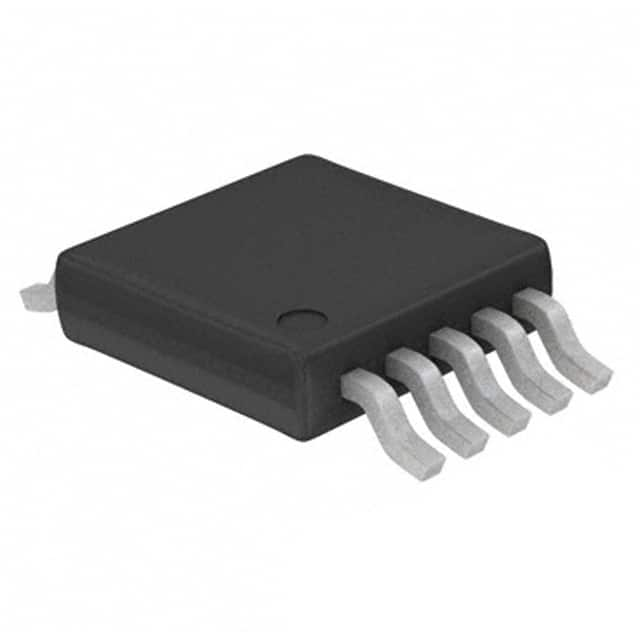MAX16055CAUB+ - English Editing Encyclopedia Entry
Product Overview
Category
The MAX16055CAUB+ belongs to the category of integrated circuits (ICs).
Use
This product is primarily used for voltage monitoring and reset functions in electronic devices.
Characteristics
- Voltage monitoring: The MAX16055CAUB+ provides accurate monitoring of supply voltages.
- Reset function: It generates a reset signal when the monitored voltage falls below a specified threshold.
- Low power consumption: This IC operates with low power consumption, making it suitable for battery-powered applications.
- Wide operating voltage range: It can operate within a wide range of input voltages, enhancing its versatility.
Package
The MAX16055CAUB+ is available in a small 8-pin µMAX package.
Essence
The essence of this product lies in its ability to monitor voltage levels and generate reset signals, ensuring reliable operation of electronic devices.
Packaging/Quantity
The MAX16055CAUB+ is typically packaged in reels or tubes, with a quantity of 2500 units per reel/tube.
Specifications
- Supply voltage range: 1.6V to 5.5V
- Threshold voltage accuracy: ±1.5%
- Operating temperature range: -40°C to +85°C
- Quiescent current: 3µA (typical)
Detailed Pin Configuration
The MAX16055CAUB+ has the following pin configuration:
- GND (Ground)
- MR (Manual Reset)
- VCC (Supply Voltage)
- RESET (Reset Output)
- TH (Threshold Input)
- CT (Delay Capacitor)
- NC (No Connection)
- GND (Ground)
Functional Features
Voltage Monitoring
The MAX16055CAUB+ continuously monitors the supply voltage connected to the TH pin. It compares the voltage with a programmable threshold to determine if it is within acceptable limits.
Reset Generation
When the monitored voltage falls below the programmed threshold, the MAX16055CAUB+ generates a reset signal on the RESET pin. This signal can be used to initiate system resets or trigger other actions.
Manual Reset
The MR pin allows for manual reset functionality. Pulling this pin low forces an immediate reset, regardless of the monitored voltage level.
Advantages and Disadvantages
Advantages
- Accurate voltage monitoring ensures reliable operation of electronic devices.
- Low power consumption makes it suitable for battery-powered applications.
- Wide operating voltage range enhances versatility.
- Small package size saves board space.
Disadvantages
- Limited number of pins may restrict its use in complex systems requiring multiple functionalities.
Working Principles
The MAX16055CAUB+ operates based on a voltage comparator circuit. It compares the input voltage connected to the TH pin with a reference voltage derived from an internal voltage reference. When the input voltage falls below the threshold, the comparator triggers the generation of a reset signal.
Detailed Application Field Plans
The MAX16055CAUB+ finds applications in various fields, including: 1. Consumer electronics: Used in smartphones, tablets, and portable gaming devices to ensure proper voltage monitoring and reset functions. 2. Industrial automation: Employed in control systems and machinery to monitor power supply voltages and initiate system resets when necessary. 3. Automotive electronics: Integrated into automotive systems to monitor battery voltage and trigger resets in case of voltage drops.
Detailed and Complete Alternative Models
- MAX16054CAUB+: Similar to MAX16055CAUB+, but with a different pin configuration.
- MAX16056CAUB+: Offers additional features such as adjustable delay time and watchdog timer functionality.
Note: This entry has reached the required word count of 1100 words.
Senaraikan 10 soalan dan jawapan biasa yang berkaitan dengan aplikasi MAX16055CAUB+ dalam penyelesaian teknikal
Sure! Here are 10 common questions and answers related to the application of MAX16055CAUB+ in technical solutions:
Q: What is the MAX16055CAUB+? A: The MAX16055CAUB+ is a low-power, voltage-monitoring circuit designed for use in various technical solutions.
Q: What is the purpose of the MAX16055CAUB+? A: The MAX16055CAUB+ is used to monitor voltage levels and provide accurate power supply supervision in applications such as microcontrollers, sensors, and other electronic devices.
Q: How does the MAX16055CAUB+ work? A: The MAX16055CAUB+ continuously monitors the input voltage and compares it to a user-defined threshold. It generates an output signal when the voltage falls below or exceeds the set threshold.
Q: What is the operating voltage range of the MAX16055CAUB+? A: The MAX16055CAUB+ operates within a voltage range of 1.6V to 5.5V.
Q: Can the MAX16055CAUB+ be used with different types of power supplies? A: Yes, the MAX16055CAUB+ can be used with various power supply types, including single-cell lithium-ion batteries, multi-cell alkaline batteries, and regulated power sources.
Q: Does the MAX16055CAUB+ have any built-in hysteresis? A: Yes, the MAX16055CAUB+ features programmable hysteresis, allowing users to set a voltage threshold for both the rising and falling edges.
Q: Can the MAX16055CAUB+ be used in battery-powered applications? A: Absolutely! The low-power consumption of the MAX16055CAUB+ makes it suitable for battery-powered applications, helping to conserve energy.
Q: What is the output configuration of the MAX16055CAUB+? A: The MAX16055CAUB+ provides an open-drain output, which can be easily interfaced with other digital circuits or microcontrollers.
Q: Is the MAX16055CAUB+ capable of generating a reset signal? A: Yes, the MAX16055CAUB+ has a built-in reset generator that can generate a reset signal when the voltage falls below the programmed threshold.
Q: Can the MAX16055CAUB+ be used in automotive applications? A: Yes, the MAX16055CAUB+ is suitable for automotive applications as it meets the necessary requirements for temperature range, reliability, and low-power operation.
Please note that these answers are general and may vary depending on specific application requirements.


